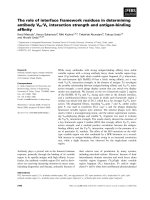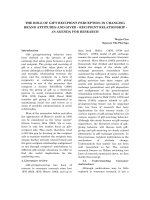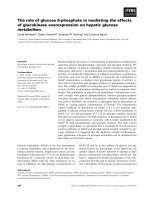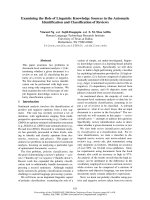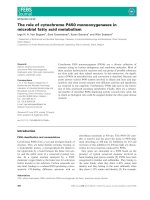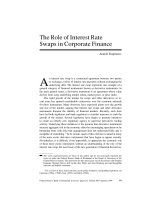the role of wasp family members in dictyostelium discoideum cell migration
Bạn đang xem bản rút gọn của tài liệu. Xem và tải ngay bản đầy đủ của tài liệu tại đây (27.64 MB, 213 trang )
Glasgow Theses Service
Davidson, Andrew J. (2014) The role of WASP family members in
Dictyostelium discoideum cell migration. PhD thesis.
Copyright and moral rights for this thesis are retained by the author
A copy can be downloaded for personal non-commercial research or
study, without prior permission or charge
This thesis cannot be reproduced or quoted extensively from without first
obtaining permission in writing from the Author
The content must not be changed in any way or sold commercially in any
format or medium without the formal permission of the Author
When referring to this work, full bibliographic details including the
author, title, awarding institution and date of the thesis must be given.
The role of WASP family members in
Dictyostelium discoideum cell migration
By Andrew J. Davidson
Submitted in fulfillment of the requirements for the
degree of Doctor of Philosophy
The Beatson Institute for Cancer Research
College of Medical, Veterinary and Life Sciences
University of Glasgow
February 2014
!
!
!
2!
2!
Abstract
The WASP family of proteins are nucleation-promoting factors that dictate the
temporal and spatial dynamics of Arp2/3 complex recruitment, and hence actin
polymerisation. Consequently, members of the WASP family, such as SCAR/WAVE
and WASP, drive processes such as pseudopod formation and clathrin-mediated
endocytosis, respectively. However, the nature of functional specificity or overlap of
WASP family members is controversial and also appears to be contextual. For
example, some WASP family members appear capable of assuming each other’s roles
in cells that are mutant for certain family members. How the activity of each WASP
family member is normally limited to promoting the formation of a specific subset of
actin-based structures and how they are able to escape these constraints in order to
substitute for one another, remain unanswered questions. Furthermore, how the
WASP family members collectively contribute to complex processes such as cell
migration is yet to be addressed.
To examine these concepts in an experimentally and genetically tractable system we
have used the single celled amoeba Dictyostelium discoideum. The regulation of
SCAR via its regulatory complex was investigated by dissecting the Abi subunit. Abi
was found to be essential for complex stability but not for its recruitment to the cell
cortex or its role in pseudopod formation. The roles of WASP A were examined by
generating a wasA null strain. Our results contradicted previous findings suggesting
that WASP A was essential for pseudopod formation and instead demonstrated that
WASP A was required for clathrin-mediated endocytosis. Unexpectedly, WASP A –
driven clathrin-mediated endocytosis was found to be necessary for efficient uropod
retraction during cell migration and furrowing during cytokinesis. Finally, we created
a double scrA/wasA mutant, and found that it was unable to generate pseudopodia.
Therefore, we were able to confirm that SCAR is the predominant driver of
pseudopod formation in wild-type Dictyostelium cells, and that only WASP A can
assume its role in the scrA null. Surprisingly, the double mutant was also deficient in
bleb formation, showing that these proteins are also necessary for this alternative,
Arp2/3 complex-independent mode of motility. This implies that there exists interplay
between the different types of actin-based protrusions and the molecular pathways
that underlie their formation.
!
!
3!
3!
Table of Contents
Abstract! !2!
Table of Contents! !3!
List of Figures! !6!
Supplementary Movies! !8!
Acknowledgements! !10!
Author’s Declaration! !11!
Abbreviations! !12!
Chapter 1 Introduction! !14!
1.1 Dictyostelium dicoideum as a model organism! !15!
1.2 The actin cytoskeleton! !18!
1.3 The WASP family! !28!
1.4 Actin-driven cellular processes! !35!
1.5 Aims of thesis! !42!
Chapter 2 Materials and Methods! !45!
2.1 Molecular Cloning! !46!
2.2 DNA constructs! !47!
2.3 Cell biology! !49!
2.4 Microscopy! !55!
2.5 Antibodies! !57!
2.6 List of IR strains! !57!
2.7 List of plasmids! !58!
2.8 List of primers! !60!
2.9 Buffer recipes! !60!
Chapter 3 Abi is required for SCAR complex stability, but not localisation! !63!
3.1 The design and implementation of the Abi deletion series! !64!
3.2 Abi fragments stabilise both SCAR and the SCAR complex! !65!
3.3 Abi fragments rescue the growth of the abiA null! !71!
3.4 SCAR complex containing truncated Abi localises normally in migrating
cells! !73!
3.5 Loss of 1
st
alpha helix of Abi exacerbates the cytokinesis defect of abiA null
! !77!
!
!
4!
4!
3.6 Chapter 3 summary! !79!
Chapter 4 WASP is not required for pseudopod formation but instead confines Rac
activity to the leading edge! !81!
4.1 Creation of a Dictyostelium wasA inducible knockout! !82!
4.2 Generation of a Dictyostelium wasA null! !84!
4.3 The wasA null has a cytokinesis defect! !86!
4.4 Other phenotypes of the wasA null! !91!
4.5 WASP A is not required for pseudopod formation! !93!
4.6 WASP A does contribute to cell motility! !97!
4.7 The wasA null has functional but disorganised myosin-II within the uropod
! !99!
4.8 The wasA null has a severe defect in CME! !101!
4.9 WASP family members account for the residual recruitment of the Arp2/3
complex to clathrin-coated pits in wasA nulls! !106!
4.10 The accumulation of CCPs in the cleavage furrow of the dividing wasA null
disrupts cytokinesis! !108!
4.11 The accumulation of CCPs in the rear of the chemotaxing wasA null
impairs uropod retraction! !111!
4.12 The wasA null has no defect in adhesion turnover during chemotaxis! !113!
4.13 Rac is inappropriately activated in the uropod of the wasA null! !116!
4.14 Aberrant Rac activity induces SCAR-promoted actin polymerisation within
the uropod of the wasA null! !118!
4.15 Chapter 4 summary! !121!
Chapter 5 WASP family proteins are required for both Arp2/3 complex dependent
and independent modes of migration! !123!
5.1 Creation of the double scrA/wasA mutant! !124!
5.2 The double scrA/wasA mutant has a severe growth defect! !125!
5.3 WASP A alone is responsible for the residual pseudopod formation in the
double scrA/wasA mutant! !130!
5.4 The double scrA/wasA mutant has a specific defect in cell motility! !137!
5.5 The double scrA/wasA mutant has a defect in bleb-based migration! !139!
5.6 Bleb-based motility does not depend on wasA alone! !144!
5.7 The double scrA/wasA mutant retains robust actomyosin contractility! !146!
!
!
5!
5!
5.8 The double scrA/wasA mutant possesses a robust actin cortex! !148!
5.9 The double scrA/wasA mutant retains normal cortex turnover! !151!
5.10 Blebbing can be induced in the double scrA/wasA mutant! !157!
5.11 Chapter 5 summary! !159!
Chapter 6 Discussion! !160!
6.1 Abi is not required for pseudopod formation! !161!
6.2 Abi modulates SCAR complex activity during cytokinesis! !162!
6.3 WASP A is not required for normal pseudopod formation! !163!
6.4 WASP A is required for clathrin-mediated endocytosis in Dictyostelium! !164!
6.5 WASP A is required for efficient cytokinesis! !166!
6.6 WASP A contributes indirectly to cell migration! !167!
6.7 SCAR and WASP A are essential for Dictyostelium growth! !170!
6.8 WASP family members are essential for pseudopod formation! !171!
6.9 WASP family members are required for bleb-based migration! !172!
6.10 SCAR and WASP A are not required for bleb formation! !173!
6.11 Final summary! !177!
Biblography! !179!
Publications arising from this work! !199!
!
!
6!
6!
List of Figures
1.1 Key concepts and regulators underlying actin polymerisation -p26-27
1.2 The domain structure and regulation of WASPs and SCARs -p32-33
1.3 The localisation of SCAR and WASP A in motile Dictyostelium -p38
1.4 WASPs support vesicle internalisation during CME -p41
3.1 Design and implementation of the Abi deletion series -p66-67
3.2 Identification of a minimal Abi fragment that stabilises SCAR -p69-70
3.3 Abi fragments rescue the growth defect of the abiA null -p72
3.4 Abi fragments support normal SCAR complex dynamics in the abiA null -p74-75
3.5 The N-terminus of Abi regulates the SCAR complex during cytokinesis -p78
4.1 Generation of wasA knock out cell lines -p83
4.2 WASP A is not required for Dictyostelium viability -p85
4.3 The wasA null has a defect in cytokinesis -p87-89
4.4 Other notable phenotypes of the wasA null -p92
4.5 WASP A is not required for chemotaxis
or pseudopod formation -p94-95
4.6 The motility of the wasA null is impaired by its enlarged uropod -p98
4.7 The wasA null possesses functional but disorganised myosin-II -p100
4.8 The wasA null has a severe defect in CME -p102-104
4.9 WASP B and C, but not SCAR accounted for residual CME in wasA null -p107
4.10 CCPs aggregate within the cleavage furrow of dividing wasA nulls -p109-110
4.11 CCPs accumulate within the uropod of the chemotaxing wasA null -p112
4.12 Adhesions do not accumulate in the uropod of the wasA null -p114
4.13 Rac is aberrantly activated in the uropod of the wasA null -p117
4.14 SCAR promoted actin polymerisation occurs within the wasA null uropod -p119-120
5.1 Creation of the inducible double scrA/wasA mutant -p126-127
5.2 One of SCAR or WASP A is essential for axenic growth -p129
5.3 The double scrA/wasA mutant has a severe motility defect -p132-135
5.4 The double scrA/wasA mutant is capable of driven cell spreading -p138
!
!
7!
7!
5.5 The double scrA/wasA mutant has a defect in bleb-based motility -p140-142
5.6 WASP A alone is not required for robust bleb-based motility -p145
5.7 The double scrA/wasA mutant retains actomyosin contractility -p147
5.8 The double mutant possesses normal levels of F-actin -p149-150
5.9 The double scrA/wasA mutant possesses a dynamic actin cortex -p152-155
5.10 The double scrA/wasA mutant is capable of bleb formation -p158
6.1 The role of WASP A in Dictyostelium uropod retraction and cytokinesis -p169
6.2 The proposed role of the Arp2/3 complex in bleb-based migration -p176
!
!
8!
8!
Supplementary Movies
Movie 1: The localisation of the SCAR complex in starved abiA nulls co-expressing
HSPC300-GFP (green channel) and either full length WT Abi or the ΔAbiΔ fragment.
Cells were visualised by TIRF and DIC microscopy.
Movie 2: Arp2/3 complex and F-actin dynamics in wild-type and wasA null cells
chemotaxing towards folate in the under-agarose assay. Cells were co-expressing
GFP-ArpC4 (Arp2/3 complex, green channel) and Lifeact-mRFP (F-actin, red
channel) and were visualised using spinning disc confocal microscopy
Movie 3: WASP A and CCP dynamics in a cell undergoing cytokinesis. GFP-WASP
A (green channel) and CLC-mRFP (Red channel) were co-expressed in the wasA
null. Cells were compressed under an agarose slab and imaged using TIRF and DIC
microscopy.
Movie 4: The aggregation of CCPs in the cleavage furrow of the wasA null. CLC-
mRFP (Red channel) was expressed in wild-type and wasA null cells stably
expressing GFP-PCNA (nuclear marker, green channel). Mitotic cells were identified
using the GFP-PCNA marker (visualised by epifluorescence) and CCPs were
observed using TIRF microscopy. White arrows highlight extreme CCP aggregation
co-inciding with impaired furrowing in the wasA nulls.
Movie 5: Distribution of active Rac in chemotaxing wasA nulls. The GFP-tagged
GBD of PakB (green channel) was co-expressed with CLC-mRFP (Red channel) in
wild-type and wasA nulls. Cells were then imaged using TIRF and DIC microscopy,
whilst chemotaxing towards folate in the under-agarose assay.
Movie 6: Arp2/3 complex and F-actin dynamics in control, scrA mutant and double
scrA/wasA mutant cells chemotaxing towards folate in the under-agarose assay. Cells
were co-expressing GFP-ArpC4 (Arp2/3 complex, green channel) and Lifeact-mRFP
(F-actin, red channel) and visualised using spinning disc confocal microscopy
!
!
9!
9!
Movie 7: Arp2/3 complex and F-actin dynamics in severely compressed control, scrA
mutant and wasA mutant cells chemotaxing towards folate in the under-agarose assay.
Under such conditions cells move primarily through blebs. Cells were co-expressing
GFP-ArpC4 (Arp2/3 complex, green channel) and Lifeact-mRFP (F-actin, red
channel) and visualised using spinning disc confocal microscopy.
Movie 8: Cortical FRAP of control and double scrA/wasA mutant cells. GFP-actin
was expressed in cells and a region of the cortex was photobleached (white box
number 1., white circle indicates timing of bleach) and its fluorescence recovery was
compared to a non-bleached region (white box number 2.) FRAP and visualisation of
GFP-actin was conducted using spinning disc confocal microscopy.
Movie 9: Arp2/3 complex and F-actin dynamics in a severely compressed double
scrA/wasA mutant cell. Cells were compressed under an agarose slab with a weight
placed on top of it and this induced robust blebbing. Cells were co-expressing GFP-
ArpC4 (Arp2/3 complex, green channel) and Lifeact-mRFP (F-actin, red channel) and
visualised using spinning disc confocal microscopy.
!
!
10!
10!
Acknowledgements
I’d like to thank Robert Insall for giving me the opportunity to work with him in his
lab, and for giving me the freedom to to follow my own interests. I will always be
grateful for his patience and his guidance and for our long discussions about my
projects and science in general.
I thank Peter Thomason for his tireless proofreading of not only this thesis, but of all
my scientific writing. He has always been there to listen to my problems, and to
encourage me when I have failed and for that I am eternally grateful.
I’d like to acknowledge Douwe Veltman, Seiji Ura and Jason King. Together with
Robert and Peter, they have taught me everything I know. I will always remember our
time together in the lab fondly.
So much of this thesis has its roots in the work of Douwe and my success owes much
to the experiments he undertook whilst in the Insall lab.
The vast majoity of the data generated during the course of my PhD was derived
through microscopy, which just wouldn’t have been possible without the help of the
support staff in the BAIR facility. Margret O’Prey in particular was of great help with
getting me started on the spinning disc confocal microscope.
There are many so many other people at the Beatson who have helped me and I have
not thanked here individually. For this I can only appologise and offer an
encompassing thank you.
I am grateful to my family and friends for sticking bye me, I owe you all more of my
time than I have been able to give you in the last four years.
Lastly, I would not have achieved this with out the support of Fiona, to whom I
simply give my thanks and my love.
!
!
11!
11!
Author’s Declaration
I declare that, except where explicit reference is made to the contribution of others,
that this dissertation is the result of my own work and has not been submitted for any
other degree at the University of Glasgow or any other institution.
Some data and text excerpts presented here have been previously published as part of
the following paper:
‘Abi is required for modulation and stability of the SCAR/WAVE complex, but not
localization or activity.’
Davidson, A. J., Ura, S., Thomason, P. A., Kalna, G. and Insall R. H.
(PMID: 24036345)
!
!
12!
12!
Abbreviations
Abi Abelson tyrosine kinase interactor
Arp Actin-related protein
ATP/ADP Adenosine triphosphate/diphosphate
Ax2/3 Axenic strain 2/3
cAMP Cyclic adenosine monophosphate
cAR1 cAMP receptor 1
CCP Clathrin-coated pit
Cdc42 Cell division control protein 42
CME Clathrin-mediated endocytosis
Cobl Cordon-bleu
CRIB Cdc42/Rac interactive binding domain
DNA Deoxyribonucleic acid
DOX Doxycycline
DRF Diaphanous related formin
E. coli Escherichia coli
F-actin Filamentous actin
FH1/2/3 Formin homology domain 1/2/3
FRAP Fluorescence recovery after photobleaching
G-actin Globular actin
GBD GTPase binding domain
GTP/GDP Guanosine triphosphate/disphosphate
HSPC300 haematopoietic stem/progenitor cell protein 300
JMY Junction mediating and regulatory protein
Lat. A Latrunculin A
MHC Myosin heavy chain
MLC
Myosin light chain
mRNA messenger ribonucleic acid
N-/C-terminus Amino/carboxyl terminus
NPF Nucleation promoting factor
Nap1 Nucleosome assembly protein 1
PCR Polymerase chain reaction
PIR121 p53 inducible protein 121
!
!
13!
13!
N-WASP Neuronal Wiskott Aldrich syndrome protein
Rac Ras-related C3 botulinum toxin substrate 1
REMI Restriction enzyme-mediated integration
SCAR/WAVE Suppressor of cAMP of receptor/WASP family verprolin
homologous protein
SHD SCAR homology domain
SIKO SCAR inducible knockout
TIRF Total internal reflection fluorescence
VCA Verprolin homology, connecting region and acidic region
domain
WASH WASP and SCAR homologue protein
WASP Wiskott Aldrich syndrome protein
WH1/2 WASP homology domain 1/2
WHAMM WASP homologue associated with actin, membranes and
microtubules
WIKO WASP A inducible knockout
WIP WASP-interacting protein
!
!
14!
14!
Chapter 1
Introduction
!
!
15!
15!
1.1 Dictyostelium dicoideum as a model organism
1.1.1 Introduction to Dictyostelium dicoideum
Dictyostelium discoideum (henceforth often simply referred to as ‘Dictyostelium’) is a
free-living amoeba that is found in forest soils where it feeds on bacteria and yeast
(Raper, 1935). As a model organism, Dictyostelium discoideum has many advantages.
First and foremost, it is a simple eukaryote that exhibits many of the same cellular
behaviours as higher eukaryotic cells such as those found in mammals. Examples
include cell motility and cell division, both of which are more comparable to
mammalian cells than in simpler models such as budding yeast. It has a relatively
small, haploid genome that is divided between six chromosomes and has been fully
sequenced (Cox, Vocke, Walter, Gregg, & Bain, 1990, Eichinger et al., 2005). Such
factors, combined with the availability of a wide range of molecular tools, makes
Dictyostelium very amenable to genetic manipulation, especially in comparison to
slow growing, diploid mammalian cell lines.
Dictyostelium discoideum has been used to study a wide range of cell biology.
However, this thesis shall focus on the use of Dictyostelium to investigate the actin
cytoskeleton during processes such as cell migration and cytokinesis.
1.1.2 The lifecycle of Dictyostelium discoideum
In the presence of plentiful food, Dictyostelium exists in a single-celled, vegetative
state during which it reproduces asexually. Dictyostelium can also undergo sexual
reproduction, which is initiated when two different mating types fuse to initiate
macrocyst formation (Saga & Yanagisawa, 1983). Recently, it has been shown that
variation at a single genetic locus underlies the three different mating types in
Dictyostelium (Bloomfield, Skelton, Ivens, Tanaka, & Kay, 2010).
The aggregation of Dictyostelium during multicellular development is one of the best-
studied aspects of the Dictyostelium lifecycle. This process is initiated by starvation
and accumulates in the formation of resistant spores secured within a fruiting body or
!
!
16!
16!
‘sorocarp’. The sorocarp consists of the stalk (or “sorophore”), which supports the
spore containing head or (‘sorus’) (Raper, 1935). Nutrient deprivation promotes the
cells to produce and secrete pulses of cyclic adenosine monophosphate (cAMP,
Gerisch & Wick, 1975). This coincides with the starvation-induced expression of the
cAMP receptor 1 (cAR1), which upon binding cAMP transiently stimulates adenylate
cyclase to produce and release more cAMP (Klein, Vaughan, Borleis, & Devreotes,
1987, Dinauer, MacKay, & Devreotes, 1980). In a monolayer of cells, the pulsatile
release of cAMP stimulates neighbouring cells to secrete cAMP and so forth,
resulting in waves of cAMP production travelling through the monolayer (Tomchik &
Devreotes, 1981). Since starved cells are also highly chemotactic towards cAMP, this
drives the aggregation of the Dictyostelium (Konijn, Van De Meene, Bonner, &
Barkley, 1967, Barkley, 1969). Once aggregated, the Dictyostelium undergo
differentiation and morphogenesis to first form a migratory slug or
‘pseudoplasmodium’ and then the final fruiting body.
1.1.3 Dictyostelium laboratory strains
Up until the isolation of laboratory strains that could grow in liquid culture,
Dictyostelium could only be grown in the presence of bacteria. Cells were initially
selected to grow in an aseptic, undefined medium (Sussman & Sussman, 1967).
Repeated subculture of these cells allowed the more complex components of this
medium to be diluted out and yielded cells with more efficient growth in liquid
growth (Watts & Ashworth, 1970). This ‘axenic’ strain was named ‘Ax2’ and remains
one of the major laboratory strains used by the Dictyostelium research community. An
alternative, widely used strain strain was optimised to grow in liquid culture by
mutagenesis and is known as ‘Ax3’ (Loomis, 1971).
Although the isolation of axenic strains was a key advance in the history of
Dictyostelium research, the harsh selection or mutagenesis used to derive these cells
has resulted in dramatic genomic rearrangements (Bloomfield, Tanaka, Skelton,
Ivens, & Kay, 2008). This undoubtedly underlies the numerous phenotypic
discrepancies that exist between different axenic strains and between the axenic
strains and the original NC4 isolate from the soil. An example of this is the low
vegetative motility of the axenic strains compared to the non-axenic Dictyostelium
!
!
17!
17!
isolates (Pollitt, Blagg, Ibarra, & Insall, 2006). Efforts have been made to create
axenic cells through less severe selection and one such cell line derived from NC4
was NC4A2 (Morrison & Harwood, 1992, Shelden & Knecht, 1995). The authenticity
of NC4A2 has been called into question due to it possessing identical duplications to
Ax3 (Bloomfield et al., 2008). However, NC4A2 retains the high vegetative motility
of non-axenic cell isolates, making it useful for motility studies (Pollitt et al., 2006).
1.1.4 Dictyostelium chemotaxis
Dictyostelium are highly motile cells and their movement is similar to that observed in
other migratory cells such as human neutrophils (Devreotes & Zigmond, 1988,
Andrew & Insall, 2007). As vegetative cells they are capable of robust chemotaxis
towards folic acid, which is commonly released from their bacterial prey (Pan, Hall,
& Bonner, 1972). As described in the previous section, starved Dictyostelium secrete
and become sensitive to cAMP (Konijn et al., 1967, Barkley, 1969). Chemotaxis can
be induced experimentally by introducing vegetative or starved cells to a gradient of
folic acid or cAMP respectively. Cell motility is driven by the formation of cellular
protrusions, which shall be introduced in later sections. Such properties have made
Dictyostelium a powerful model for the study of chemotaxis and cell migration. There
are currently two fundamentally different models to explain chemotaxis in
Dictyostelium and eukaryotic cells in general. The chemotactic compass model
proposes that the detection of chemoattractants (e.g. cAMP) via a transmembrane
receptor (e.g. cAR1) initiates intracellular signaling, which ultimately leads to the
extension of cellular protrusions towards the source of the chemoattractant to create a
leading edge (Weiner, 2002a & 2002b). Alternatively, it has been suggested that
motile cells perpetually generate protrusions at the front of the cell and then those
protrusions that best orient the cell towards the chemoattractant are favoured (Andrew
& Insall, 2007). Which of these two models is correct remains to be established,
however the use of Dictyostelium as a simple model for the study of chemotaxis has a
lot to offer the debate.
!
!
18!
18!
1.1.5 Dictyostelium cell division
Dictyostelium cytokinesis is remarkably similar to that observed in higher eukaryotes.
However, its cytokinesis is extremely robust to the point that different aspects of
Dictyostelium division can compensate for one another and are even often referred to
as different modes of cytokinesis in their own right (Nagasaki, de Hostos, & Uyeda,
2002). Cytokinesis A acts to pinch the cell in two through the formation of a cleavage
furrow. In suspension, cytokinesis A is entirely dependent on the action of myosin-II,
whereas on a substratum myosin-II plays a nonessential supportive role and helps
stabilise the furrow during ingression (De Lozanne & Spudich, 1987, Zang et al.,
1997, Neujahr, Heizer, & Gerisch, 1997). Cytokinesis B acts independently of
cleavage furrow formation, whereby the newly formed daughter cells migrate in
opposite directions to help physically pull themselves apart (King, Veltman,
Georgiou, Baum, & Insall, 2010, Nagasaki et al., 2002). Finally, cytokinesis C or
traction-mediated cytofission acts as a failsafe to tear up multinucleate cells
independently of mitosis (De Lozanne & Spudich, 1987, Nagasaki et al., 2002). Both
cytokinesis B and C are entirely dependent on adhesion, meaning myosin-II is
essential for cell division in suspension. The growth of mutants with severely
defective cytokinesis A can be maintained by culturing them in the presence of a
substratum, offering a unique opportunity to isolate and study the different aspects of
eukaryote cytokinesis.
1.2 The actin cytoskeleton
1.2.1 Globular actin
Monomeric or globular (G) actin is the fundamental unit of the actin cytoskeleton.
The importance of actin can be surmised from its extremely high conservation and its
sheer abundance within all eukaryotic cells. For instance, the Dictyostelium genome
encodes 41 actin and actin-related proteins (Arps) (Joseph et al., 2008). 34 of these
genes encode conventional actins, of which 17 are identical in amino acid sequence.
Mammalian actins are classed as α-, β- or γ-actins and are either involved in muscle
!
!
19!
19!
contraction (α-actin isoforms and γ2-actin) or are ubiquitously expressed in non-
muscle cells (γ1-actin and β-actin) (Vandekerckhove & Weber, 1978).
The crystal structure of G-actin revealed it to be a square or cushion-shaped molecule
composed of two similar domains each formed of two subdomains (Kabsch,
Mannherz, Suck, Pai, & Holmes, 1990). A loop with exposed hydrophobic residues
was suggested to mediate actin-actin interactions during polymerisation and this was
supported by the subsequent resolution of the crystal structure of actin dimers
(Holmes, Popp, Gebhard, & Kabsch, 1990, Kudryashov et al., 2005).
G-actin binds adenosine triphosphate (ATP), which was found to bind a cleft between
two of the domains in the crystal structure (Kabsch et al., 1990). G-actin has a very
low rate of ATP hydrolysis, which is greatly increased following polymerisation
(Pollard & Weeds, 1984). Actin polymerisation shall be discussed in more detail in
section 1.2.3.
Until recently, G-actin was believed to act solely as the substrate for actin
polymerisation. However, G-actin has also been implicated in nuclear signaling
within the cell (Zheng, Han, Bernier, & Wen, 2009). Although this is an area of
fascinating research, this thesis shall focus on the role of actin in the cytoskeleton.
1.2.2 Actin monomer binding proteins
Actin that has hydrolysed its ATP remains bound to the resulting ADP and inorganic
phosphate with the later being released only after an extended period of time (Carlier
& Pantaloni, 1986). Although ATP and ADP-bound G-actin are both capable of
polymerisation, ATP-actin polymerises more readily (Pollard, 1986). The nucleotide
status of depolymerised ADP-bound G-actin is regulated by actin monomer binding
proteins. Profilins are actin monomer binding proteins that bind G-actin and promote
the release of ADP in exchange for ATP (Goldschmidt-Clermont et al., 1992).
Therefore they act to maintain a pool of ATP-bound actin to fuel polymerisation.
Furthermore, many regulators of actin polymerisation bind profilin, which has been
proposed to concentrate ATP-bound actin at sites of polymerisation (Machesky,
Atkinson, Ampe, Vandekerckhove, & Pollard, 1994, Suetsugu, Miki, & Takenawa,
1998, Miki, Suetsugu, & Takenawa, 1998).
!
!
20!
20!
Animals (although not Dictyostelium) possess thymosin β
4
, which binds ADP bound
actin and prevents its conversion to ATP-bound actin, thus blocking repolymerisation
(Goldschmidt-Clermont et al., 1992). It was proposed that thymosin β
4
acts to prevent
the polymerisation of ADP-bound G-actin and competes with profilin to regulate the
availability of ATP-bound actin in animal cells.
1.2.3 Actin polymerisation
As introduced in the previous two sections, the principal role of G-actin is to
polymerise to form filamentous (F) actin. Pure actin monomers are capable of self-
assembling without the aid of other proteins. Actin polymerisation has been
exhaustively studied in vitro, as shall be briefly discussed in this section. The actin
filament is composed of two helical ribbons of actin, with all the monomers orientated
in one direction (Holmes et al., 1990). Historically, one end is termed the barbed end
and the other is termed the pointed end due to the appearance of the filament when
decorated with the myosin head group or S1 fragment (Huxley, 1963, Begg,
Rodewald, & Rebhun, 1978).
An actin filament elongates as long as the concentration of available G-actin is above
the dissociation constant, a threshold that is known as the critical concentration
(Kasai, Asakura, & Oosawa, 1962). F-actin depolymerises below the critical
concentration, which raises G-actin levels until conditions for polymerisation are
reached again. At the critical concentration, a steady state is reached wherein an actin
filament grows as fast as it depolymerises. At high concentration of G-actin, an actin
filament will grow at both the barbed and the pointed ends. However, the critical
concentration is lower for the barbed end than the pointed end (Pollard & Mooseker,
1981). This difference results in the elongation of F-actin at the barbed end and
depolymerisation at the pointed end. Furthermore, as discussed in the previous
section, ATP-bound actin also has a lower critical concentration than ADP-bound
actin, which favours the addition of ATP-bound actin at the barbed end of F-actin
(Pollard, 1986). Polymerisation induces the newly added actin monomer to
irreversibly hydrolyse its ATP (Carlier et al., 1988). ATP hydrolysis is not required
for the addition of subsequent actin monomers (Pollard & Weeds, 1984). Nor does
ATP hydrolysis initiate monomer dissociation. Following, hydrolysis, actin remains
!
!
21!
21!
bound to the resulting ADP and inorganic phosphate (Pi) and even the eventual
release of the Pi does not automatically initiate disassembly. Instead ATP hydrolysis
confers filament polarity whereby freshly added ATP-bound actin is enriched at the
barbed end and ADP-bound actin is depolymerised from the pointed end. In what is
commonly known as actin treadmilling, the combination of all these properties allows
the dynamic growth of an actin filament in a single direction whilst the turnover of the
filament at the other end maintains a steady state (Wegner, 1976). Actin treadmilling
is summarised in the diagram shown in figure 1.1a.
1.2.4 The Arp2/3 complex and other actin nucleators
Actin trimers rapidly elongate, but actin dimers are unstable and therefore initiation or
‘nucleation’ of the actin trimer is the limiting step in actin polymerisation (Frieden,
1983). Many different actin nucleators that act to form a stable actin dimer to induce
polymerisation have been discovered (Campellone & Welch, 2010). One of the major
actin nucleators within the cell is the highly conserved Arp2/3 complex. This complex
is composed of seven subunits including two Arps (Arp2 and Arp3), which share
sequence similarities with conventional actin (Machesky et al., 1994). Rather than
nucleating actin filaments de novo, the Arp2/3 complex initiates the polymerisation of
a new barbed-end growing off of the body of an existing filament at a 70
o
angle
(Mullins, Heuser, & Pollard, 1998). The Arp2 and Arp3 subunits are proposed to
mimic an actin dimer to nucleate a new actin filament (Kelleher, Atkinson, & Pollard,
1995, Rouiller et al., 2008). Branches form the substrate for more Arp2/3 complex
induced branches and very quickly the Arp2/3 complex can generate a very dense
meshwork of cross-linked F-actin (Svitkina & Borisy, 1999). The role of the Arp2/3
complex in actin nucleation is highlighted in figure 1.1b.
In contrast to the Arp2/3 complex, the formins nucleate actin filaments de novo and
generate linear, unbranched filaments (Pruyne et al., 2002). All formins possess two
C-terminal formin homology (FH) domains and it is the FH2 domain that is sufficient
to induce actin nucleation (Castrillon & Wasserman, 1994, Pruyne et al., 2002).
Formins act as dimers and remain associated with the barbed end of a growing
filament during elongation (Moseley et al., 2004, Xu et al., 2004). The diaphanous-
related formins (DRFs) are a subset of formins, which possess an additional FH3
!
!
22!
22!
domain that is required for DRF subcellular localisation (Petersen, Nielsen, Egel, &
Hagan, 1998). DRFs also possess a N-terminal GTPase binding domain (GBD),
which interacts with a Dia-autoregulatory domain (DAD) in the C-terminus and acts
to hold the DRF in an inactive conformation (Alberts, 2001). The binding of a
member of the Rho GTPase family to the Cdc42/Rac interactive binding (CRIB)
motif within the GBD, releases the DAD and frees the FH2 domain to nucleate actin.
The Dictyostelium genome encodes 10 identifiable formins of which two are DRFs
(Schirenbeck, Bretschneider, Arasada, Schleicher, & Faix, 2005).
Other proteins that have been found to nucleate F-actin include Spire and Cordon-bleu
(Cobl). Spire is present in Drosophila and vertebrates whereas Cobl exists only in
vertebrates. These two proteins possess tandem repeats of WASP homology 2 (WH2)
domains and create a new growing barbed-end by bringing together actin monomers
through these G-actin binding domains (Qualmann & Kessels, 2009, although debated
by Renault, Bugyi, & Carlier, 2008).
1.2.5 F-actin capping, bundling and severing proteins
Once nucleated, F-actin interacts with a host of different actin binding proteins, which
act to limit elongation, cross-link multiple filaments into different arrays or promote
filament turnover (Winder & Ayscough, 2005).
Many proteins bind actin filament ends and in doing so, prevent further elongation at
the capped site. Capping of the barbed end in general promotes filament
depolymerisation as barbed end growth is inhibited leading to net monomer loss from
the pointed end. Examples of proteins that cap barbed ends included capping protein
and gelsolin (Casella, Maack, & Lin, 1986, Wang & Bryan, 1981). Formins also cap
barbed ends, although they also simultaneously promote barbed end elongation
(Moseley et al., 2004). Dictyostelium possesses capping protein and gelsolin-related
proteins, as well as formins as described in the previous section. Capping of the
pointed end is associated with filament stabilisation as barbed end elongation is
maintained whilst monomer loss from the pointed end is prevented. Proteins that cap
the pointed end of filaments include tropomodulin and the Arp2/3 complex (Weber,
Pennise, Babcock, & Fowler, 1994, Mullins et al., 1998). Dictyostelium possesses the
Arp2/3 complex but not tropomodulin. Capping protein in particular has been shown
!
!
23!
23!
to have an important role in limiting the exponential increase in barbed ends created
by the activity of the Arp2/3 complex (Pantaloni, Boujemaa, Didry, Gounon, &
Carlier, 2000).
Other ABPs act to cross-link assembled actin filaments into different arrays to form
F-actin superstructures. Fascin and espin are examples of ABPs that cross-link actin
filaments into parallel bundles that are often found in long-thin cellular projections
(Cant, Knowles, Mooseker, & Cooley, 1994, Edwards, Herrera-Sosa, Otto, & Bryan,
1995, Bartles, Zheng, Li, Wierda, & Chen, 1998). In contrast, filamin acts to cross-
link actin filaments into orthogonal networks (Nakamura, Osborn, Hartemink,
Hartwig, & Stossel, 2007). Both α-actinin and fimbrin, along with myosin II, are
capable of cross-linking anti-parallel actin filaments (Laporte, Ojkic, Vavylonis, &
Wu, 2012). The activity of these F-actin cross-linkers underlies the formation of a
wide range of different cellular structures (Bartles, 2000, Stevenson, Veltman, &
Machesky, 2012).
Finally, F-actin severing proteins such as the ADF/cofilin family help breakdown
actin networks by promoting actin filament disassembly. ADF/cofilin increases the
rate of F-actin turnover, which is otherwise too slow to maintain the level of actin
treadmilling observed in vivo (Carlier et al., 1997). ADF/cofilin has also been shown
to have a role in debranching Arp2/3 complex generated actin meshworks, which
again acts to promote actin depolymerisation and maintain a sufficient pool of G-actin
for further polymerisation (Chan, Beltzner, & Pollard, 2009).
1.2.6 Actomyosin contractility
Myosins are molecular motors that couple ATP hydrolysis to movement along F-
actin. Myosin-II is historically known as the conventional myosin due to its
specialised role in vertebrate muscle, however it also underlies eukaryotic cell
contractility. Many unconventional myosins have also been discovered, which have
diverse roles throughout the cell (Hartman & Spudich, 2012). However, here the
focus shall be on non-muscle myosin-II and its role in actomyosin contractility.
Myosin-II is composed of a pair of intertwined heavy chains, each paired with an
essential and a regulatory light chain. The myosin heavy chain (MHC) consists of a
C-terminal tail, through which it dimerises, a flexible neck region and a N-terminal
!
!
24!
24!
head domain, which is responsible for the force production required for movement
(Hynes, Block, White, & Spudich, 1987, Toyoshima et al., 1987). The head domain
possesses both the ATP and actin binding sites (Rayment et al., 1993). The binding of
ATP has been shown to promote the head domain to detach from the F-actin, freeing
it to move or ‘step’ forward before ATP hydrolysis induces reattachment (Lymn &
Taylor, 1971, De La Cruz & Ostap, 2004). Actomyosin contractility is dependent on
the polymerisation of myosin-II dimers to form bipolar filaments, which in
Dictyostelium is regulated by the dephosphorylation of the myosin heavy chain
(Egelhoff, Lee, & Spudich, 1993). Phosphorylation of the myosin essential light chain
(MLC
E
) has also been shown to be required for myosin-II ATPase activity and
therefore motor function in Dictyostelium (Griffith, Downs, & Spudich, 1987).
However, regulation of myosin-II by phosphorylation in mammals appears very
different and is less well understood (Redowicz, 2001).
Dictyostelium possesses a single MHC encoded from the mhcA gene, making it a
good model for studying non-muscle myosin-II activity (DeLozanne, Lewis, Spudich,
& Leinwand, 1985). Surprisingly, a viable mhcA knock out was generated and
although it exhibited a severe defect in cytokinesis when cultured in suspension, it
was able to divide independently of myosin-II when grown on Petri dishes (De
Lozanne & Spudich, 1987). The ability of the mhcA null to divide in the absence of
actomyosin contractility demonstrated the robust mechanisms underlying
Dictyostelium cytokinesis as discussed in section 1.1.3. The mhcA null was shown to
have no defect in pseudopod extension, however myosin-II was needed for
maintaining cortical integrity during migration under mechanically restrictive
conditions (Laevsky & Knecht, 2003). Interestingly myosin-II contractility was not
required and instead it appeared that the actin cross-linking ability of myosin-II in the
absence of the MLC
E
was sufficient to support cell motility under restrictive
conditions. In summary, actomyosin contractility underlies a diverse range of cellular
behaviours.
1.2.7 Models of actin dynamics
Many pathogenic bacteria, such as Listeria monocytogenes and Shigella flexneri, can
hijack a host cell’s nucleation machinery to induce actin-based motility (Loisel,


